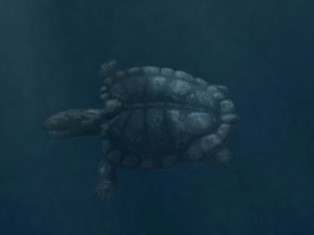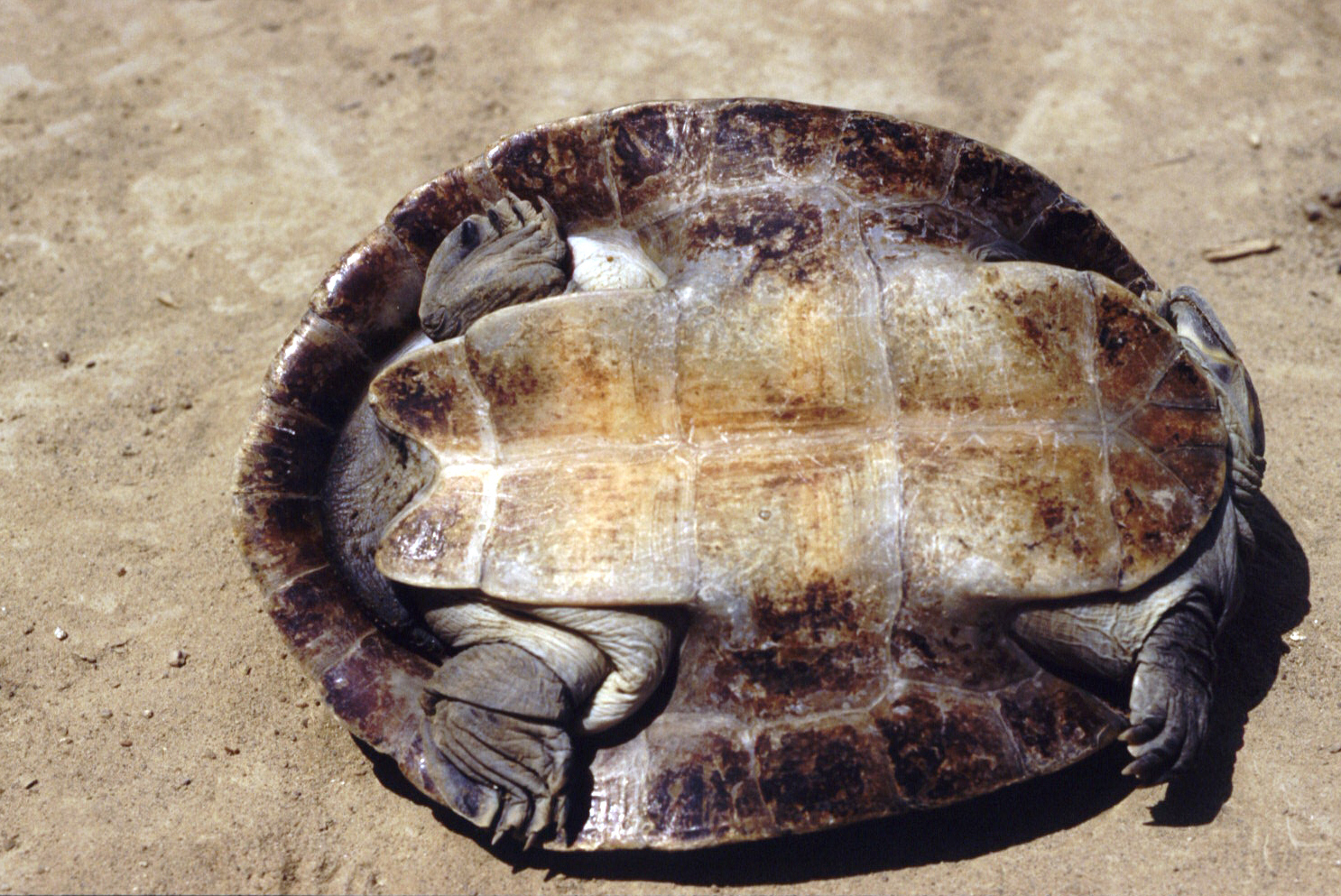|
Angolachelonia
Angolachelonia is a clade of extinct turtles from the Late Jurassic to Paleogene of Eurasia. The group is defined as all taxa derived from the ancestor of the type genus ''Angolachelys'' and '' Solnhofia'', a definition that could potentially encompass a clade of entirely marine turtles. Angolachelonia was originally inclusive of only ''Solnhofia'', ''Angolachelys'' and '' Sandownia'' when originally conceived by Octavio Mateus and colleagues in 2009, but later phylogenetic analyses by Serjocha Evers and Roger Benson in 2018 unites the family Sandownidae, including ''Angolachelys'' and ''Sandownia'' among other taxa, with the entirely Late Jurassic clade Thalassochelydia, where ''Solnhofia'' may be a basal member. While the placement of ''Solnhofia'' is weak and the clade that Angolachelonia represents may change with further analysis, the clade of Sandownidae and Thalassochelydia is well-supported, and does not collapse despite the uncertain evolutionary history of the group. T ... [...More Info...] [...Related Items...] OR: [Wikipedia] [Google] [Baidu] |
Thalassochelydia
Thalassochelydia is a clade of extinct marine turtles from the Late Jurassic and earliest Cretaceous of Europe and South America. The group is defined as including ''Eurysternum'', ''Plesiochelys'' and ''Thalassemys'' to the exclusion of ''Pelomedusa'', '' Testudo'' and '' Protostega''. While a clade uniting the families Eurysternidae, Plesiochelyidae and Thalassemydidae had been supported by phylogenetic evidence, a name was not given for the clade until 2017, when Jérémy Anquetin and colleagues coined Thalassochelydia. While inner relationships of the clade are so uncertain as to make the monophyly of the families questionable, the significant diversity of thalassochelydians makes using the potentially invalid terms useful to describe the different morphologies. The monophyly of Thalassochelydia was further supported by a later analysis by Serjocha Evers and Roger Benson in 2019, where the group, represented by '' Solnhofia'' and Plesiochelyidae was sister taxon to Sandown ... [...More Info...] [...Related Items...] OR: [Wikipedia] [Google] [Baidu] |
Sandownidae
Sandownidae is a family of extinct marine turtles from the Cretaceous and Paleogene distributed around the Atlantic Ocean and adjacent areas. The family is defined as all taxa closer to the type genus '' Sandownia'' than to ''Pelomedusa'', '' Testudo'', ''Solnhofia'', ''Eurysternum'', ''Plesiochelys'', ''Thalassemys'' or '' Protostega'', a definition that encompasses the previous concept of the clade while also excluding it from being synonymous with other clades of modern or extinct marine turtles. Sandownidae may be within the larger clade Angolachelonia, defined as inclusive of ''Angolachelys'' and ''Solnhofia'', sister to the entirely Late Jurassic marine group Thalassochelydia, although the concepts of the clades may shift with further phylogenetic analysis. Genera * '' Sandownia'' Meylan et al. 2000 Atherfield Clay Formation, England, Early Cretaceous (Aptian) * '' Brachyopsemys'' Tong and Meylan 2013 Ouled Abdoun Basin, Morocco, Paleocene (Danian) * ''Angolachelys'' Mate ... [...More Info...] [...Related Items...] OR: [Wikipedia] [Google] [Baidu] |
Testudinata
Testudinata is the group of all tetrapods with a true turtle shell. It includes both modern turtles (Testudines) and many of their extinct, shelled relatives (stem-turtles). Though it was first coined as the group containing turtles by Jacob Theodor Klein in 1760, it was first defined in the modern sense by Joyce and colleagues in 2004. Testudinata does not include the primitive stem-turtle ''Odontochelys'', which only had the bottom half of a shell. A recent phylogenetic tree of Testudinata included Angolachelonia and Testudines Turtles are an order of reptiles known as Testudines, characterized by a special shell developed mainly from their ribs. Modern turtles are divided into two major groups, the Pleurodira (side necked turtles) and Cryptodira (hidden necked t ... as sister-taxa and subgroups of Testudinata. Classification The cladogram below follows an analysis by Jérémy Anquetin in 2012. References {{Taxonbar, from=Q16114972 Reptile taxonomy Norian f ... [...More Info...] [...Related Items...] OR: [Wikipedia] [Google] [Baidu] |
Angolachelys Mbaxi
''Angolachelys'' is an extinct genus of African eucryptodiran turtle which existed in Angola during the Turonian stage of the Late Cretaceous. The type species is ''Angolachelys mbaxi''. The type MGUAN-PA includes skull, jaw, and postcranial fragments found in the Tadi Beds of the Itombe Formation. Phylogeny Cladogram A cladogram (from Greek ''clados'' "branch" and ''gramma'' "character") is a diagram used in cladistics to show relations among organisms. A cladogram is not, however, an evolutionary tree because it does not show how ancestors are related to d ... after Mateus ''et al.'' (2009). References Cryptodira Prehistoric turtle genera Turonian life Late Cretaceous reptiles of Africa Fossil taxa described in 2009 {{paleo-turtle-stub ... [...More Info...] [...Related Items...] OR: [Wikipedia] [Google] [Baidu] |
Angolachelys
''Angolachelys'' is an extinct genus of African eucryptodiran turtle which existed in Angola during the Turonian stage of the Late Cretaceous. The type species is ''Angolachelys mbaxi''. The type MGUAN-PA includes skull, jaw, and postcranial fragments found in the Tadi Beds of the Itombe Formation. Phylogeny Cladogram A cladogram (from Greek ''clados'' "branch" and ''gramma'' "character") is a diagram used in cladistics to show relations among organisms. A cladogram is not, however, an evolutionary tree because it does not show how ancestors are related to d ... after Mateus ''et al.'' (2009). References Cryptodira Prehistoric turtle genera Turonian life Late Cretaceous reptiles of Africa Fossil taxa described in 2009 {{paleo-turtle-stub ... [...More Info...] [...Related Items...] OR: [Wikipedia] [Google] [Baidu] |
Late Jurassic
The Late Jurassic is the third epoch of the Jurassic Period, and it spans the geologic time from 163.5 ± 1.0 to 145.0 ± 0.8 million years ago (Ma), which is preserved in Upper Jurassic strata.Owen 1987. In European lithostratigraphy, the name "Malm" indicates rocks of Late Jurassic age. In the past, ''Malm'' was also used to indicate the unit of geological time, but this usage is now discouraged to make a clear distinction between lithostratigraphic and geochronologic/chronostratigraphic units. Subdivisions The Late Jurassic is divided into three ages, which correspond with the three (faunal) stages of Upper Jurassic rock: Paleogeography During the Late Jurassic Epoch, Pangaea broke up into two supercontinents, Laurasia to the north, and Gondwana to the south. The result of this break-up was the spawning of the Atlantic Ocean. However, at this time, the Atlantic Ocean was relatively narrow. Life forms of the epoch This epoch is well known for many famous types of dinosau ... [...More Info...] [...Related Items...] OR: [Wikipedia] [Google] [Baidu] |
Cretaceous Turtles
The Cretaceous ( ) is a geological period that lasted from about 145 to 66 million years ago (Mya). It is the third and final period of the Mesozoic Era, as well as the longest. At around 79 million years, it is the longest geological period of the entire Phanerozoic. The name is derived from the Latin ''creta'', "chalk", which is abundant in the latter half of the period. It is usually abbreviated K, for its German translation ''Kreide''. The Cretaceous was a period with a relatively warm climate, resulting in high eustatic sea levels that created numerous shallow inland seas. These oceans and seas were populated with now- extinct marine reptiles, ammonites, and rudists, while dinosaurs continued to dominate on land. The world was ice free, and forests extended to the poles. During this time, new groups of mammals and birds appeared. During the Early Cretaceous, flowering plants appeared and began to rapidly diversify, becoming the dominant group of plants across the Earth b ... [...More Info...] [...Related Items...] OR: [Wikipedia] [Google] [Baidu] |
Protostegidae
Protostegidae is a family of extinct sea turtle, marine turtles that lived during the Cretaceous period. The family includes some of the largest sea turtles that ever existed. The largest, ''Archelon'', had a head long. Like most sea turtles, they had flattened bodies and flipper (anatomy), flippers for front appendages; protostegids had minimal carapace, shells like Dermochelyidae, leatherback turtles of modern times. Anatomy As some of the first sea turtle, marine turtles, the protostegids set the general body plan for future species of sea turtles. They had a generally depressed turtle body plan, complete with four limbs, a short tail, and a large head at the end of a relatively short neck. Like other sea turtles, they possessed oar-like front appendages especially evolved for swimming in the open ocean. Similar to the still-extant taxon, extant, possibly closely related Dermochelyidae, protostegids possessed extremely reduced carapaces. Some specimens had skeletal protrusio ... [...More Info...] [...Related Items...] OR: [Wikipedia] [Google] [Baidu] |
Chelonioidea
Sea turtles (superfamily Chelonioidea), sometimes called marine turtles, are reptiles of the order Testudines and of the suborder Cryptodira. The seven existing species of sea turtles are the flatback, green, hawksbill, leatherback, loggerhead, Kemp's ridley, and olive ridley sea turtles. All six of the sea turtle species present in US waters (all of those listed above except the flatback) are listed as endangered and/or threatened under the Endangered Species Act. The seventh sea turtle species is the flatback, which exists in the waters of Australia, Papua New Guinea and Indonesia. Sea turtles can be separated into the categories of hard-shelled (cheloniid) and leathery-shelled ( dermochelyid).Wyneken, J. 2001. The Anatomy of Sea Turtles. U.S Department of Commerce NOAA Technical Memorandum NMFS-SEFSC-470, 1-172 pp. There is only one dermochelyid species which is the leatherback sea turtle. Description For each of the seven types of sea turtles, females and males are the sa ... [...More Info...] [...Related Items...] OR: [Wikipedia] [Google] [Baidu] |
Pleurodira
The Pleurodira are one of the two living suborders of turtles, the other being the Cryptodira. The division between these two suborders represents a very deep evolutionary divide between two very different types of turtles. The physical differences between them, although anatomical and largely internal, are nonetheless significant, and the zoogeographic implications of them are substantial. The Pleurodira are known more commonly as the side-necked turtles and the name Pleurodira quite literally translates to side neck, whereas the Cryptodira are known as hidden-necked turtles. The Pleurodira turtles are currently restricted to freshwater habitats in the Southern Hemisphere, largely to Australia, South America, and Africa. Within the Pleurodira, three living families are represented: Chelidae, also known as the Austro-South American side-necked turtles, the Pelomedusidae, also known as the African mud terrapins, and the Podocnemididae, also known as the American side-neck river tur ... [...More Info...] [...Related Items...] OR: [Wikipedia] [Google] [Baidu] |
Testudines
Turtles are an order (biology), order of reptiles known as Testudines, characterized by a special turtle shell, shell developed mainly from their ribs. Modern turtles are divided into two major groups, the Pleurodira (side necked turtles) and Cryptodira (hidden necked turtles), which differ in the way the head retracts. There are 360 living and recently extinct species of turtles, including land-dwelling tortoises and freshwater terrapins. They are found on most continents, some islands and, in the case of sea turtles, much of the ocean. Like other Amniote, amniotes (reptiles, birds, and mammals) they breathe air and do not lay eggs underwater, although many species live in or around water. Turtle shells are made mostly of bone; the upper part is the domed Turtle shell#Carapace, carapace, while the underside is the flatter plastron or belly-plate. Its outer surface is covered in scale (anatomy), scales made of keratin, the material of hair, horns, and claws. The carapace bon ... [...More Info...] [...Related Items...] OR: [Wikipedia] [Google] [Baidu] |
Macrobaenidae
Macrobaenidae is an extinct family of turtles, known from the Early Cretaceous to Paleogene of Laurasia. Their relationships to other turtles and whether or not they form a monophlyletic group are controversial. They are typically interpreted as stem or crown group cryptodires, but some more recent analyses have found them to lie outside crown group Testudines. Macrobaenids can be distinguished from other testudinatans by the presence of a carotid fenestra, cruciform plastron with strap-like epiplastra, and a lack of extragulars. Genera *''Anatolemys'' Central Asia, Late Cretaceous ( Khodzhakul Formation, Uzbekistan, Cenomanian, Bissekty Formation, Uzbekistan, Turonian, Bostobe Formation, Kazakhstan, Santonian Yalovach Formation, Tajikistan, Santonian) *'' Appalachemys'' Mooreville Chalk, Alabama, Late Cretaceous (Santonian–Campanian) *'' Asiachelys'' Khulsangol Formation, Mongolia, Early Cretaceous (Albian) *'' Aurorachelys'' Kanguk Formation, Canada,Turonian *'' Cha ... [...More Info...] [...Related Items...] OR: [Wikipedia] [Google] [Baidu] |




